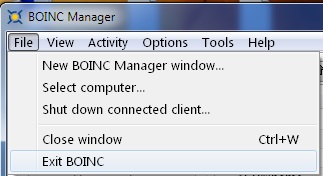

Please look at our post on Installing the Official Raspberry PI OS on your Pi. Even though you can install any other Linux distribution on your PI and go ahead to run BOINC, we will use the official Raspberry PI OS for this post. The BOINC can run on several platforms, including Windows, Linux, and macOS. Set up BOINC on your Raspberry Pi Step 1: Install the Official Raspberry Pi OS
#BOINC MANAGER HOW TO#
How to set up Ubuntu Server on Raspberry Pi 4.How to manage swap on your Raspberry Pi.How to set up a Raspberry Pi VPN server.Also, did you know if you don’t have an ethernet cable or monitor, you can still connect your Raspberry Pi to a wireless network (WIFI)? Please look at our post Connecting to Wi-Fi & Enabling SSH Without Monitor on Raspberry Pi. Please look at these two posts: How to SSH into Raspberry Pi and Set up VNC Server on Raspberry Pi. For example, instead of struggling to get a display monitor, you can connect to your Pi via SSH for command-line access or via VNC for graphical access. Tip: We have listed some of these requirements as optional since you don’t necessarily need them to work on your Raspberry Pi.

Let’s dive in! Requirements (A must-have) In this post, our computational device of choice is a Raspberry Pi. Leave your device to work on the project.Select a project you wish to contribute to.To start contributing to science through BOINC, we will follow the three simple steps below: Your contribution can accelerate the pace of many important research projects. This project supports many computing hardware devices ranging from Android smartphones, PCs, Small Board Computers like the Raspberry Pi, AEON Graphics processing unit, and much more.


 0 kommentar(er)
0 kommentar(er)
